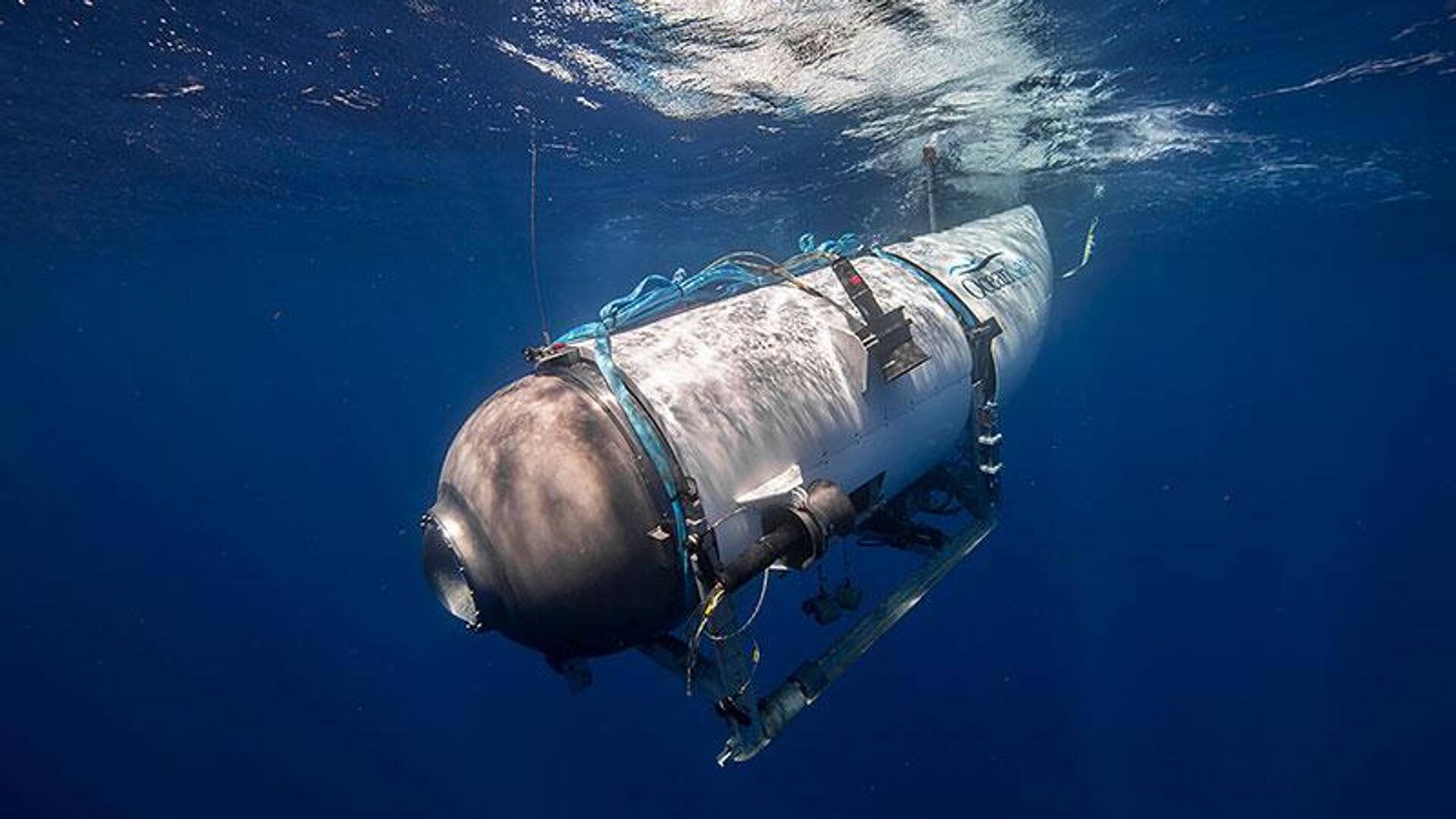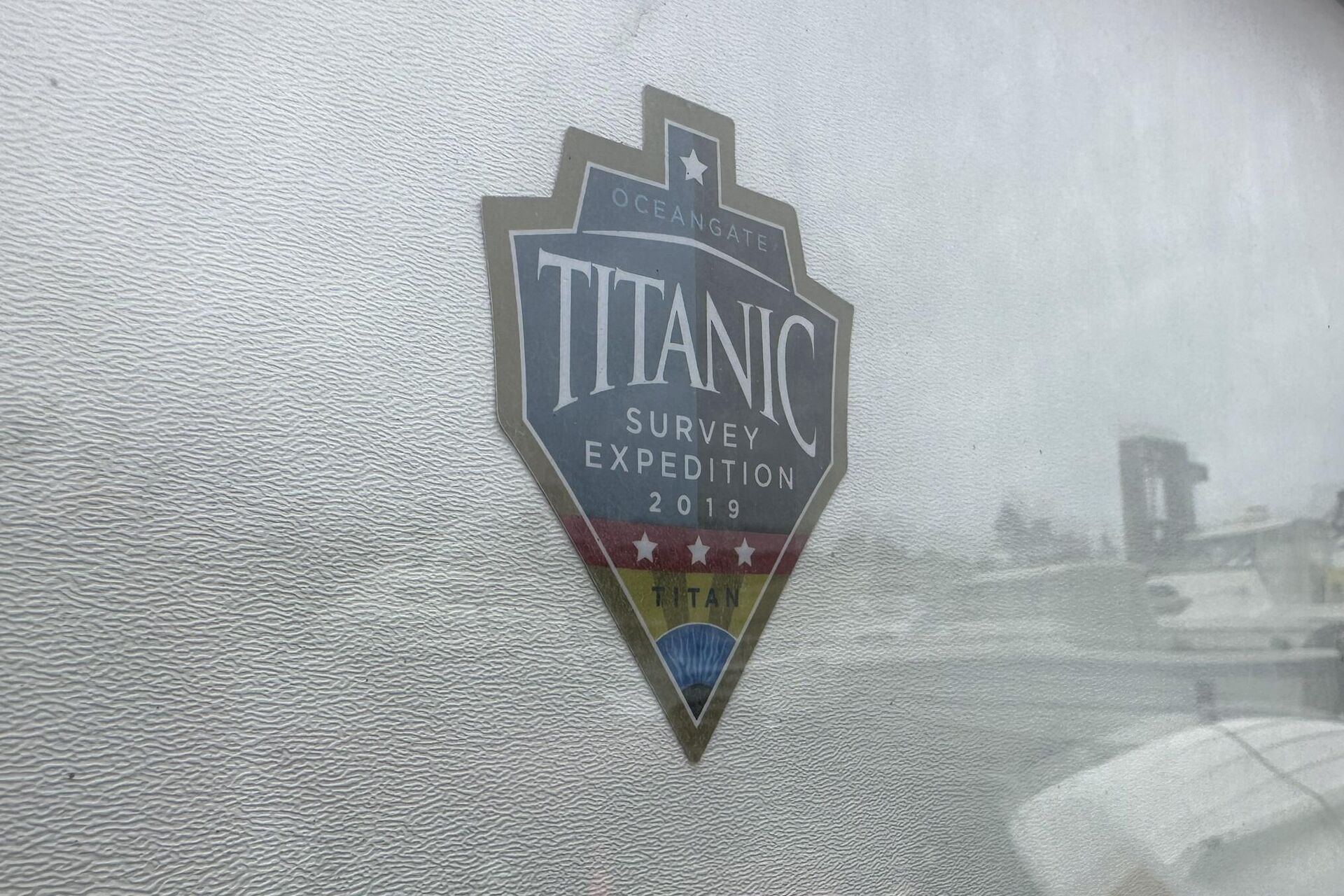https://sputniknews.in/20230623/what-happened-to-the-titanic-submarine-2638205.html
What Happened to the Titanic Submarine?
What Happened to the Titanic Submarine?
Sputnik India
All five passengers aboard the OceanGate submersible to see the sunken Titanic at a depth of nearly 13,000 feet, were declared dead after the discovery of the debris 600 feet from the Titanic's bow in the North Atlantic.
2023-06-23T21:07+0530
2023-06-23T21:07+0530
2023-06-23T21:07+0530
titanic
submarine
us
canada
united kingdom (uk)
atlantic ocean
pakistan
business
https://cdn1.img.sputniknews.in/img/07e7/06/14/2582340_0:50:801:500_1920x0_80_0_0_609a0a40c7d07aad4e0f86d095f6fe24.jpg
The deep sea expedition to explore the remains of the Titanic shipwreck in the North Atlantic Ocean resulted in a tragic event leaving all the five passengers onboard the missing submersible dead.While the rescue team blames a "catastrophic implosion" for the devastating accident, the precise moment and how the implosion occurred still remain a mystery.What is Catastrophic Implosion?A "catastrophic implosion" refers to the inward collapse or failure of the vessel caused by immense pressure in the deep sea. A catastrophic collapse can occur when a structure can no longer withstand the excessive pressure within a confined space, causing a sudden and forceful failure.In the case of the Titanic submersible, the investigation team is still probing where or how deep the submarine was when the implosion occurred.When the submersible began its descent on Sunday, in less than two hours, the vessel lost contact with the surface.According to Rick Murcar, the international training director at the National Association of Cave Divers, the Titanic wreck lies at a depth where the underwater pressure is approximately 5,600 pounds per square inch, which is several hundred times higher than the pressure we encounter on the surface.A catastrophic implosion is “incredibly quick,” taking place within just a fraction of a millisecond, Aileen Maria Marty, a former naval officer and professor at Florida International University, said. “Ultimately, among the many ways in which we can pass, that’s painless.” Recovery Operation While experts suggest that there is a very low chance of recovering any bodies, with the rescue team will continue to search the sea floor in hopes of discovering more information about what led to the implosion.Calling the underwater environment “incredibly complex", the US Coast Guard said that they will continue the search in an effort to recover whatever they can, however, it added that putting together a specific timeline of events would take time.In the debris, a Titan’s nose cone and two pressure hulls have been recovered so far.Tom Maddox, the CEO of Underwater Forensic Investigators, who took part in a Titanic expedition in 2005, told media, “What they would do now is go back to that site and, like cookie crumbs, try to find a trail as to where that would lead."Maddox added that the debris pieces could still be “slightly buoyant” and be carried further away by ocean currents. Timeline of the Titanic Sub TragedyJune 16: Five passengers embarked on a voyage to the North Atlantic Ocean aboard the Polar Prince Support Ship heading to the site of the sunken Titanic wreck.June 18: The five passengers began the dive in the submersible from the Polar Prince Support Ship stationed on the surface.The Polar Prince Support Ship's owner Miawpukek Maritime Horizon Services stated that the dive began at approximately 9 a.m. and its last communication with the surface took place at 11:47 a.m. Although it was expected that the submersible would resurface at 6:10 p.m., it did not appear, and the authorities were alerted at 6:35 p.m.A full-scale rescue mission was launched to recover the missing sub and crew that disappeared 400 miles away from the southeast of Newfoundland, Canada.June 20: The United State Coast Guard said that a Canadian maritime surveillance aircraft detected banging sound from underwater in that area every 30 minutes but were unable to locate the exact location and the source of it. This gave a ray of hope to the authorities and the families of the passengers about them being still alive under the deep sea. The clock was ticking as the vessel was equipped with only 96 hours of oxygen that would last till Thursday.June 22: On Thursday, a remote-controlled vehicle was sent into the deep North Atlantic, and within hours of being deployed to the ocean floor, the debris field was detected.The authorities confirmed the submersible had imploded, saying there does not seem to be a connection between the banging noises and where the debris was found.A senior US Navy official told the media that the noises were likely some form of natural life or sounds given off by other ships and vessels that were part of the search effort. The US Coast Guard said on Thursday it had set up sonar buoys in the water for at least 72 hours but they did not record any sign of an implosion.How OceanGate Expeditions Are Operated?OceanGate Expedition charges $250,000 (INR 20.52 million) per person for the eight-day expedition to the Titanic shipwreck. As per its website, the expedition was started in 2021, in which passengers are taken to 3,800 m (12,500ft) beneath the surface at the bottom of the Atlantic.The famous wreckage site is about 600km (370 miles) off the coast of Newfoundland and lies in two parts.While a full dive to the wreck, including the descent and ascent, takes eight hours, the single dive takes six hours to reach the Titanic site, explore, and return to the surface.The expedition lasts over a week and sets off from the Canadian city of St. John's in Newfoundland. Who Were Passengers Inside Titanic Submersible?The five people on board the Titanic submersible included Hamish Harding, a 58-year-old British businessman and explorer, Pakistani-native British businessman Shahzada Dawood, 48, and his son, Suleman Dawood, 19, and 77-year-old French explorer Paul-Henry Nargeolet. The fifth person, the pilot, is OceanGate Chief Executive Stockton Rush.Stockton RushThe 61-year-old Stockton Rush founded OceanGate in 2009 with a mission of “increasing access to the deep ocean through innovation.” In a series of interviews, Rush said he believes deeply that the sea, rather than the sky, offers humanity the best shot at survival when the Earth’s surface becomes uninhabitable.Hamish HardingHailing from the United Arab Emirates, the British businessman and adventurer was the chairman of Action Aviation, an aircraft brokerage.Harding gained fame through his numerous expeditions such as serving as part of a flight crew that set a new world record for circumnavigating the globe via both poles at the fastest possible speed.He was one of the first people to dive to the Challenger Deep in the Pacific Ocean, widely believed to be the deepest point in the world’s oceans.He also went to space on the Blue Origin flight; and was part of two record-breaking trips to the South Pole.Paul-Henri (PH) NargeoletFrench diver Paul-Henri “PH” Nargeolet had decades of experience exploring the Titanic. He served as the director of underwater research at RMS Titanic Inc., the company that has exclusive rights to salvage artifacts from the ship.According to his biography on the company’s website, Nargeolet completed 35 dives to the Titanic wreck and supervised the recovery of 5,000 artifacts. He also spent 22 years in the French Navy.Shahzada Dawood and his son Suleman Pakistani-native British billionaire Shahzada Dawood and his son, Suleman Dawood, were from a prominent business family.Shahzada was the vice-chairman of the Karachi-based conglomerate Engro and had a wide range of investments in energy, agriculture, petrochemicals, and telecommunications. His company made a revenue of 350 billion rupees ($1.2 billion) in 2022.Shahzada's father Hussain Dawood is regularly listed among Pakistan's richest men by the local press.
https://sputniknews.in/20230623/all-passengers-on-titanic-submersible-dead-oceangate-2631593.html
us
canada
united kingdom (uk)
atlantic ocean
pakistan
Sputnik India
feedback.hindi@sputniknews.com
+74956456601
MIA „Rossiya Segodnya“
2023
Sangeeta Yadav
https://cdn1.img.sputniknews.in/img/07e6/0c/0f/110602_0:0:641:640_100x100_80_0_0_c298016a79eb02ef8caa9d1f688c12a5.jpg
Sangeeta Yadav
https://cdn1.img.sputniknews.in/img/07e6/0c/0f/110602_0:0:641:640_100x100_80_0_0_c298016a79eb02ef8caa9d1f688c12a5.jpg
News
en_IN
Sputnik India
feedback.hindi@sputniknews.com
+74956456601
MIA „Rossiya Segodnya“
Sputnik India
feedback.hindi@sputniknews.com
+74956456601
MIA „Rossiya Segodnya“
Sangeeta Yadav
https://cdn1.img.sputniknews.in/img/07e6/0c/0f/110602_0:0:641:640_100x100_80_0_0_c298016a79eb02ef8caa9d1f688c12a5.jpg
what has happened to the titanic submarine, why was the titanic submarine imploded, what caused the titanic submarine to implode, titanic submarine what happened, titanic submarine news, what happened to the titanic submarine 2023, what happened to the submarine implosion, catastrophic implosion submarine, catastrophic implosion meaning, implosion submarine meaning, oceangate implosion, ocean gate submarine update, submarine implosion example, what happens when a submarine implodes, titanic submarine implosion cause, titanic submarine implosion meaning, missing titanic submersible, horror indie video game titled "iron lung", submarine, sales of the iron lung game have gone up, david szymanski the developer of the game, sale of 'iron lung' skyrocketing pakistani entrepreneur, exploration of the titanic ruins in the north atlantic, missing titanic submersible, karachi-based conglomerate engro, shahzada dawood, son suleman, vessel lost all communication while at a depth of 12,500ft underwater, pakistani entrepreneur, exploration of the titanic ruins in the north atlantic, missing titanic submersible, karachi-based conglomerate engro, shahzada dawood, son suleman, united state coast guard, canadian aircraft, p-3 maritime surveillance aircraft, newfoundland, canada, titan submersible, us navy, hamish harding, shahzada dawood, suleman dawood, paul-henry nargeolet, oceangate, stockton rush, polar prince, condolences, grief, tribute, foreign secretary of the united kingdom, james cleverly, 'titanic' movie director james cameron
what has happened to the titanic submarine, why was the titanic submarine imploded, what caused the titanic submarine to implode, titanic submarine what happened, titanic submarine news, what happened to the titanic submarine 2023, what happened to the submarine implosion, catastrophic implosion submarine, catastrophic implosion meaning, implosion submarine meaning, oceangate implosion, ocean gate submarine update, submarine implosion example, what happens when a submarine implodes, titanic submarine implosion cause, titanic submarine implosion meaning, missing titanic submersible, horror indie video game titled "iron lung", submarine, sales of the iron lung game have gone up, david szymanski the developer of the game, sale of 'iron lung' skyrocketing pakistani entrepreneur, exploration of the titanic ruins in the north atlantic, missing titanic submersible, karachi-based conglomerate engro, shahzada dawood, son suleman, vessel lost all communication while at a depth of 12,500ft underwater, pakistani entrepreneur, exploration of the titanic ruins in the north atlantic, missing titanic submersible, karachi-based conglomerate engro, shahzada dawood, son suleman, united state coast guard, canadian aircraft, p-3 maritime surveillance aircraft, newfoundland, canada, titan submersible, us navy, hamish harding, shahzada dawood, suleman dawood, paul-henry nargeolet, oceangate, stockton rush, polar prince, condolences, grief, tribute, foreign secretary of the united kingdom, james cleverly, 'titanic' movie director james cameron
The deep sea expedition to
explore the remains of the Titanic shipwreck in the
North Atlantic Ocean resulted in a tragic event leaving all the five passengers onboard the missing submersible dead.
While the rescue team blames a
"catastrophic implosion" for the devastating accident, the precise moment and how the implosion occurred still remain a mystery.
What is Catastrophic Implosion?
A "
catastrophic implosion" refers to the inward
collapse or failure of the vessel caused by immense pressure in the deep sea.
A catastrophic collapse can occur when a structure can no longer withstand the excessive pressure within a confined space, causing a sudden and forceful failure.
In the case of the Titanic submersible, the investigation team is still probing where or how deep the submarine was when the implosion occurred.
When the submersible began its descent on Sunday, in less than two hours, the vessel lost contact with the surface.
According to Rick Murcar, the international training director at the National Association of Cave Divers, the Titanic wreck lies at a depth where the underwater pressure is approximately 5,600 pounds per square inch, which is several hundred times higher than the pressure we encounter on the surface.
A catastrophic implosion is “incredibly quick,” taking place within just a fraction of a millisecond, Aileen Maria Marty, a former naval officer and professor at Florida International University, said.
“The entire thing would have collapsed before the individuals inside would even realize that there was a problem,” Marty told the media.
“Ultimately, among the many ways in which we can pass, that’s painless.”
While experts suggest that there is a very low chance of recovering any bodies, with the rescue team will continue to search the sea floor in hopes of discovering more information about what led to the implosion.
Calling the underwater environment “incredibly complex", the US Coast Guard said that they will continue the search in an effort to recover whatever they can, however, it added that putting together a specific timeline of events would take time.
In the debris, a Titan’s nose cone and two pressure hulls have been recovered so far.
Tom Maddox, the CEO of Underwater Forensic Investigators, who took part in a Titanic expedition in 2005, told media, “What they would do now is go back to that site and, like cookie crumbs, try to find a trail as to where that would lead."
Maddox added that the debris pieces could still be “slightly buoyant” and be carried further away by ocean currents.
“So the big project right now is going to be trying to collect those parts. They’ll mark them, they’ll indicate where they were, and they’ll lay out a map of where those parts were found,” Maddox said.
Timeline of the Titanic Sub Tragedy
June 16: Five passengers embarked on a voyage to the North Atlantic Ocean aboard the Polar Prince Support Ship heading to the site of the sunken Titanic wreck.
June 18: The five passengers began the dive in the submersible from the Polar Prince Support Ship stationed on the surface.
The Polar Prince Support Ship's owner Miawpukek Maritime Horizon Services stated that the dive began at approximately 9 a.m. and its last communication with the surface took place at 11:47 a.m.
Although it was expected that the submersible would resurface at 6:10 p.m., it did not appear, and the authorities were alerted at 6:35 p.m.
A full-scale
rescue mission was launched to recover the missing sub and crew that disappeared 400 miles away from the southeast of Newfoundland, Canada.
June 20: The United State Coast Guard said that a Canadian maritime surveillance aircraft detected banging sound from underwater in that area every 30 minutes but were unable to locate the exact location and the source of it.
This gave a ray of hope to the authorities and the families of the passengers about them being still alive under the deep sea.
The clock was ticking as the vessel was equipped with only 96 hours of oxygen that would last till Thursday.
June 22: On Thursday, a remote-controlled vehicle was sent into the deep North Atlantic, and within hours of being deployed to the ocean floor, the debris field was detected.
The authorities confirmed the submersible had imploded, saying there does not seem to be a connection between the banging noises and where the debris was found.
A senior US Navy official told the media that the noises were likely some form of natural life or sounds given off by other ships and vessels that were part of the search effort.
The US Coast Guard said on Thursday it had set up sonar buoys in the water for at least 72 hours but they did not record any sign of an implosion.
How OceanGate Expeditions Are Operated?
OceanGate Expedition charges $250,000 (INR 20.52 million) per person for the eight-day expedition to the Titanic shipwreck.
As per its website, the expedition was started in 2021, in which passengers are taken to 3,800 m (12,500ft) beneath the surface at the bottom of the Atlantic.
The famous wreckage site is about 600km (370 miles) off the coast of Newfoundland and lies in two parts.
While a full dive to the wreck, including the descent and ascent, takes eight hours, the single dive takes six hours to reach the Titanic site, explore, and return to the surface.
The expedition lasts over a week and sets off from the Canadian city of St. John's in Newfoundland.
Who Were Passengers Inside Titanic Submersible?
The five people on board the Titanic submersible included Hamish Harding, a 58-year-old British businessman and explorer,
Pakistani-native British businessman Shahzada Dawood, 48, and his son, Suleman Dawood, 19, and 77-year-old French explorer Paul-Henry Nargeolet.
The fifth person, the pilot, is OceanGate Chief Executive Stockton Rush.
The 61-year-old Stockton Rush founded OceanGate in 2009 with a mission of “increasing access to the deep ocean through innovation.”
In a series of interviews, Rush said he believes deeply that the sea, rather than the sky, offers humanity the best shot at survival when the Earth’s surface becomes uninhabitable.
Hailing from the United Arab Emirates, the British businessman and adventurer was the chairman of Action Aviation, an aircraft brokerage.
Harding gained fame through his numerous expeditions such as serving as part of a flight crew that set a new world record for circumnavigating the globe via both poles at the fastest possible speed.
He was one of the first people to dive to the Challenger Deep in the Pacific Ocean, widely believed to be the deepest point in the world’s oceans.
He also went to space on the Blue Origin flight; and was part of two record-breaking trips to the South Pole.
Paul-Henri (PH) Nargeolet
French diver Paul-Henri “PH” Nargeolet had decades of experience exploring the Titanic.
He served as the director of underwater research at RMS Titanic Inc., the company that has exclusive rights to salvage artifacts from the ship.
According to his biography on the company’s website, Nargeolet completed 35 dives to the Titanic wreck and supervised the recovery of 5,000 artifacts. He also spent 22 years in the French Navy.
Shahzada Dawood and his son Suleman
Pakistani-native British billionaire Shahzada Dawood and his son, Suleman Dawood, were from a prominent business family.
Shahzada was the vice-chairman of the Karachi-based conglomerate Engro and had a wide range of investments in energy, agriculture, petrochemicals, and telecommunications. His company made a revenue of 350 billion rupees ($1.2 billion) in 2022.
Shahzada's father Hussain Dawood is regularly listed among Pakistan's richest men by the local press.






